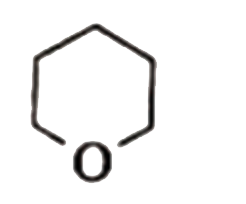In the given reaction
Br∣CH2−(CH2)3−CH2OHNaOH−−−−−−−−−→Toluene140∘C(X)
'X' will be
OH∣CH2−(CH2)4−CH2OH
CH2=CH−(CH2)3−CH2OH
CH3−OH∣CH−(CH2)3−CH2OH

The correct Answer is:D
To solve the given reaction step by step, we need to analyze the reactants and the conditions provided.
Step 1: Identify the Reactants
The reactant is 1-bromopentanol, which can be represented as:
Br-CH2−CH2−CH2−CH2OH
Step 2: Understand the Reaction Conditions
The reaction is conducted in the presence of sodium hydroxide (NaOH) and toluene at a temperature of 140°C. This indicates that we are likely dealing with a nucleophilic substitution or elimination reaction.
Step 3: Determine the Reaction Mechanism
At elevated temperatures, NaOH can facilitate the elimination of bromide (Br) from the alkyl halide. This is typically done through an E2 mechanism, especially since we have a good leaving group (Br) and a strong base (NaOH).
Step 4: Predict the Product
The elimination reaction will lead to the formation of an alkene. In this case, the bromine atom will be removed, and a double bond will be formed between the adjacent carbon atoms.
The structure of the product (alkene) will be:
CH2=CH−CH2−CH2OH
This compound is 1-pentene with a hydroxyl group (alcohol) on the terminal carbon.
Step 5: Finalize the Product
The final product 'X' will be:
X=CH2=CH−CH2−CH2OH
Conclusion
Thus, the product 'X' formed in the reaction is an alkene with an alcohol functional group.
The reactant is 1-bromopentanol, which can be represented as:
Br-CH2−CH2−CH2−CH2OH
The reaction is conducted in the presence of sodium hydroxide (NaOH) and toluene at a temperature of 140°C. This indicates that we are likely dealing with a nucleophilic substitution or elimination reaction.
At elevated temperatures, NaOH can facilitate the elimination of bromide (Br) from the alkyl halide. This is typically done through an E2 mechanism, especially since we have a good leaving group (Br) and a strong base (NaOH).
The elimination reaction will lead to the formation of an alkene. In this case, the bromine atom will be removed, and a double bond will be formed between the adjacent carbon atoms.
CH2=CH−CH2−CH2OH
This compound is 1-pentene with a hydroxyl group (alcohol) on the terminal carbon.
The final product 'X' will be:
X=CH2=CH−CH2−CH2OH
Thus, the product 'X' formed in the reaction is an alkene with an alcohol functional group.
Similar Questions
Knowledge Check
In the given reaction:
CH3−OH∣CH−OH∣C∣OH−CH3HiO4−−→(A)+(B)
(A) and (B) respectively be:ACH3CHO and CH3CHOBCH3COCH3 and CH3CHOCCH3COCH3 and CH3COCH3DCH3COOH and CH3COOCH3
In the given reaction
CH3−Br∣CH−CH2−COOHNaOH−−−→(X).
'X' will be
View SolutionIn the given reaction CH3−CH2−Br∣CH−CH=CH2Alc.KOH/Δ−−−−−−−−→(X) X will be
View SolutionIn the given reaction,
CH3−CH∣CH3−O∣∣C−CH2−CH3CF3CO3H−−−−−→(X)
as main product, 'X' will be
View SolutionThe major product formed in the reaction
CH3CH=CH−O∣∣C−CH3NaBH4−−−−−−−−→H2O,CH3OH is
View SolutionIn the given reaction [C6H5−CH2−CH2−⊕N(CH3)2−CH2−CH3]ΘOHΔ−−→ (X) as major product will be
View SolutionThe give reaction
H−CH2−CH3∣C∣CH3−Br ΘOH−−−−−→HO−CH2−CH3∣C∣CH3−H
Is an example of
View SolutionIn the given reaction CH3−CH3∣C∣CH3−CH2−BrΔ−−→[X]
[X] will be
View Solution
